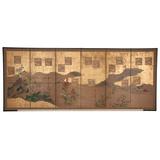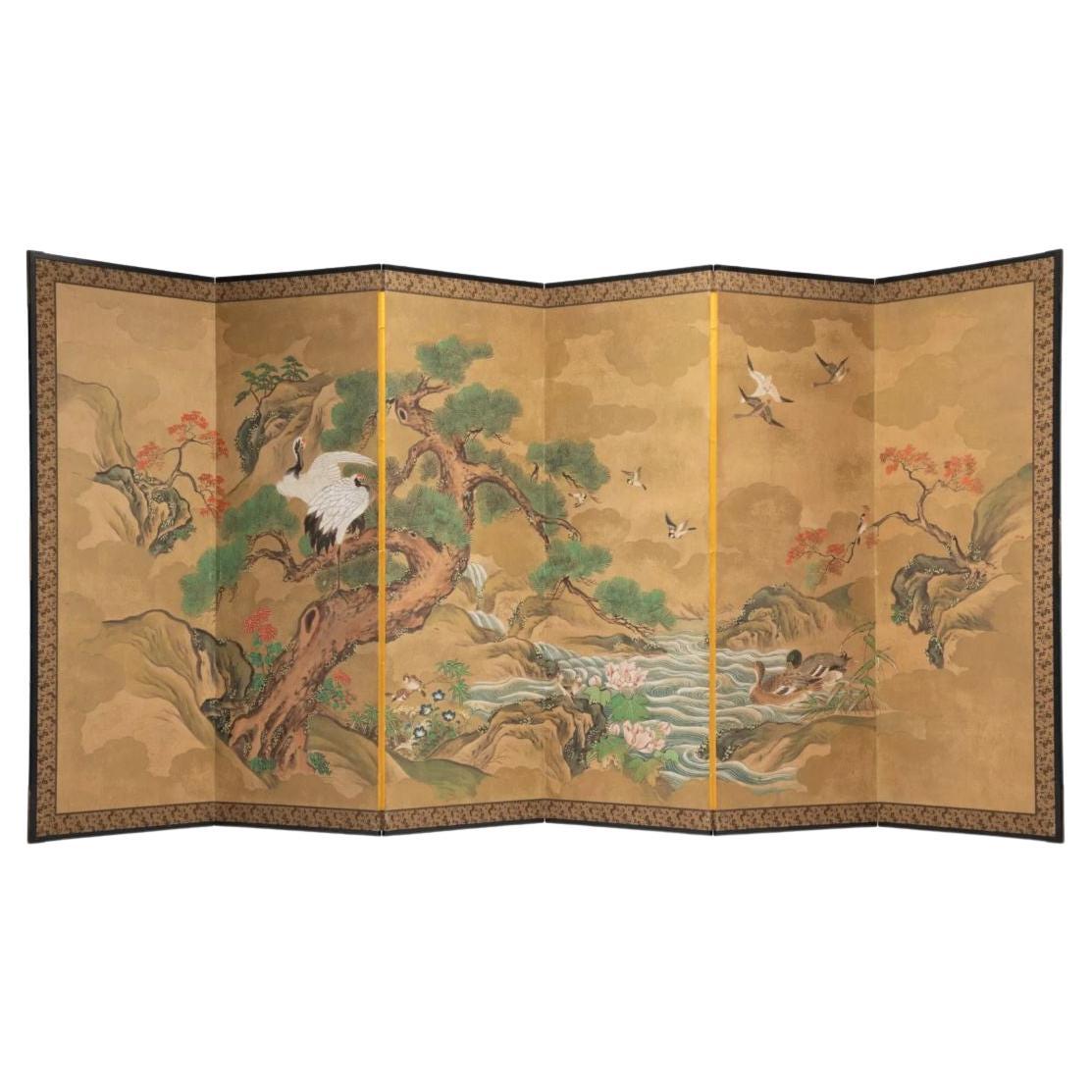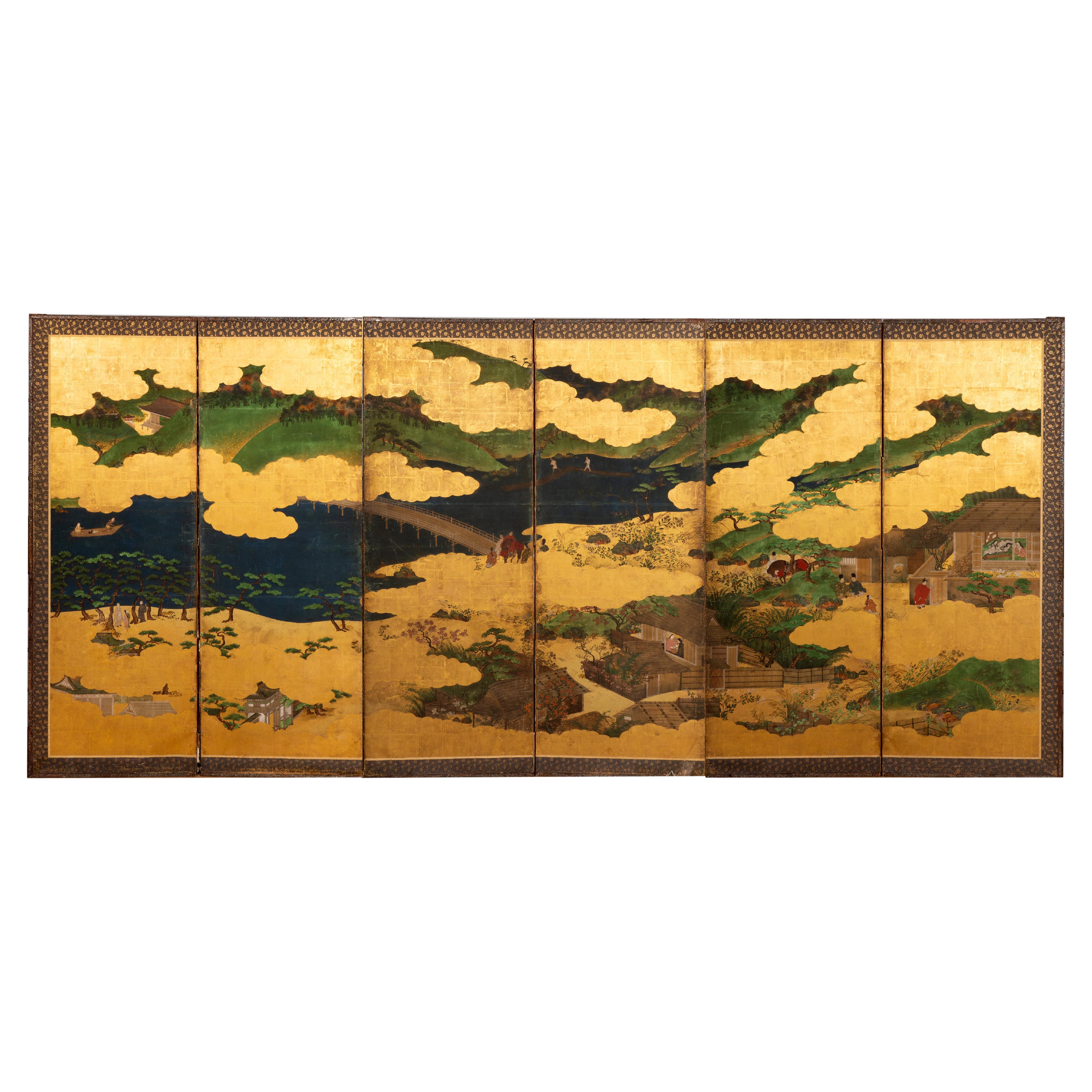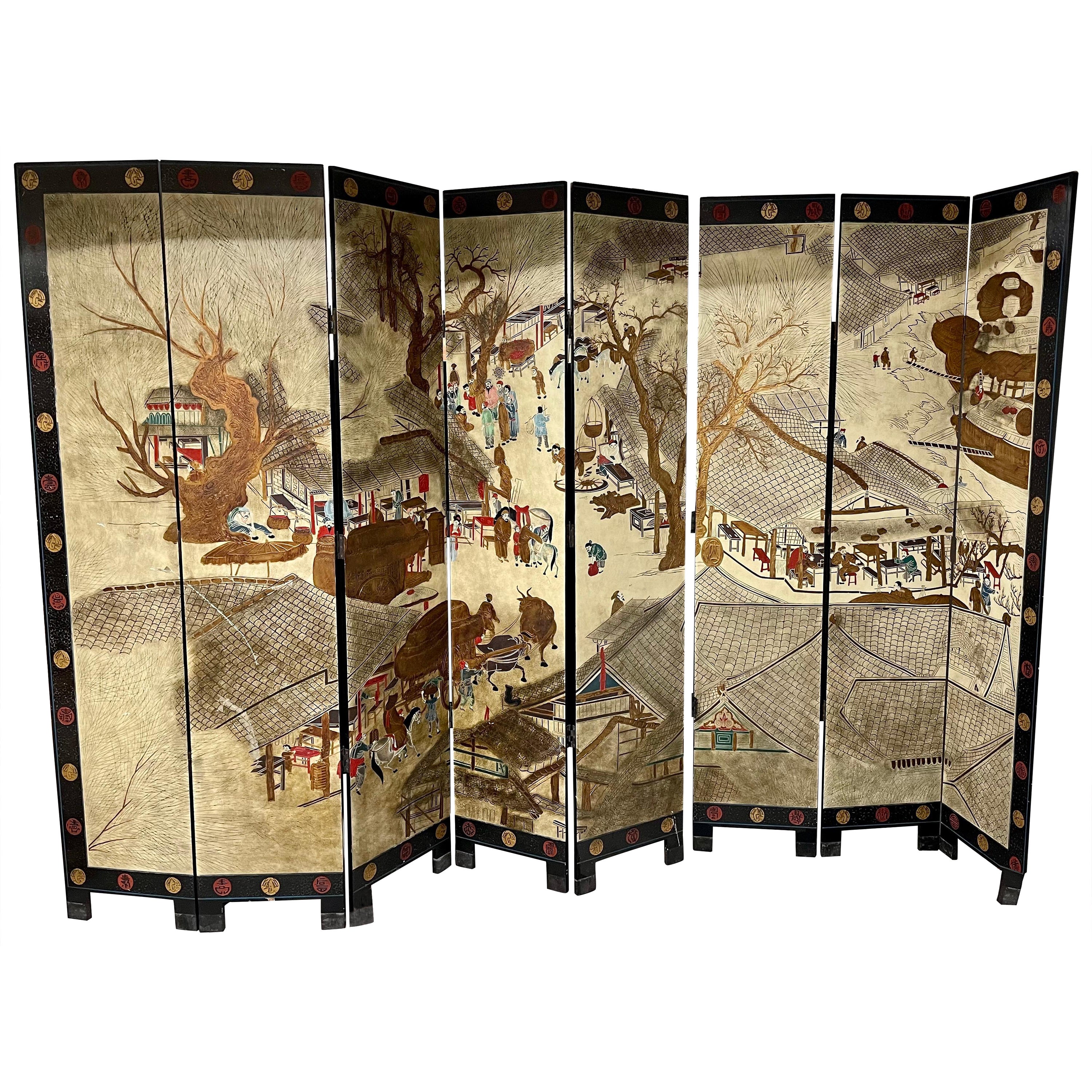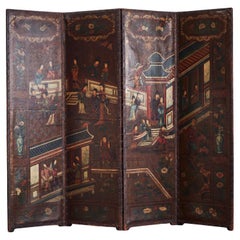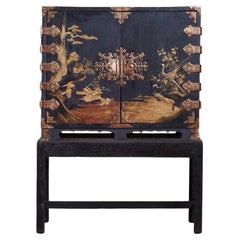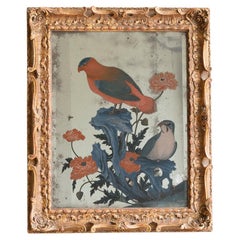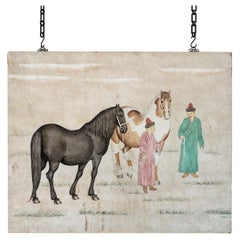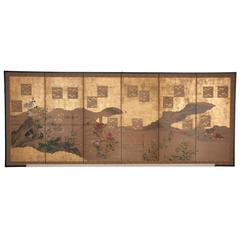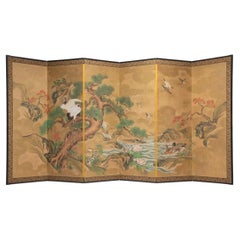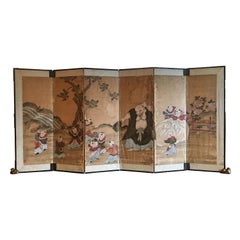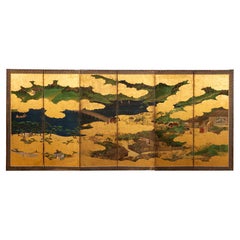Items Similar to A Single Late 19th Century Six Panel Paper Screen, in the manner of Soga Chokuan
Want more images or videos?
Request additional images or videos from the seller
1 of 10
A Single Late 19th Century Six Panel Paper Screen, in the manner of Soga Chokuan
$22,611.94
£16,500
€19,249.93
CA$30,972.71
A$34,448.41
CHF 17,987.89
MX$419,200.52
NOK 229,732.80
SEK 215,448.84
DKK 143,669.60
Shipping
Retrieving quote...The 1stDibs Promise:
Authenticity Guarantee,
Money-Back Guarantee,
24-Hour Cancellation
About the Item
Six gouache painted scenes of tethered hawks, laid down to form a six panel screen, with pigment and ink on rice paper, surrounded by thickly set gold leaf border, and Japanese silk outer bordered wooden frame. Late Edo (1615-1868) – Meji period (1868-1912), in the manner of renowned Japanese painter Soga Chokuan (Japanese, active ca. 1596-1615) recognised for his bird-and-flower paintings, and particularly celebrated for his depictions of falconry. Commissioned by prominent samurai to paint either individual or sets of tethered hawk images for folding screens, the details of his life are mostly undocumented, however Soga’s son, Nichokuan (literally, Chokuan II), continued the well documented ‘Soga School, which is known for impressive renderings of hawks and avian compositions.
Soga Chokuan (active circa 1596-1610, of the Momoyama Period) and his son Nichokuan (active circa 1620-1660) were powerfully expressive painters who created highly charged, at times overtly violent images. Virtually every subject painted by Chokuan and Nichokuan became a vehicle for expressing suppressed tensions and peculiar fascinations. A study of the documents of Chokuan and Nichokuan, and paintings by their hands reveals that these two artists were probably descendants of the Echizen Soga school, a family also renowned for eccentric art. Here we see hawks tethered to their perches, awaiting release by their masters, which symbolized military preparedness and valour. Their fearsome beauty and predatory features -sharp beaks, keen eyes, long curving talons – made them metaphors of martial training and the warrior spirit. Taken as a whole, the style of Chokuan and Nichokuan can be seen as a natural outgrowth of Echizen Soga art, and the lasting Soga school legacy can be considered a continuous, willful rebellion against the mainstream of Japanese art.
Comparables;
Original Momoyama Period (Inscriptions by Ittō Jōteki (Shōteki) Japanese, before 1606), at Met Museum New York (Accession Number: 2018.449.1, .2)
19th Century Late Edo Period, (Edo (1615-1868)-Meji period (1868-1912), also At Met Musueum New York (Accession Number: 14.76.67a-l)
Further Reading;
Lillehoj, Elizabeth Ann (1988). The Art of Soga Chokuan and Nichokuan, Two Painters of Sixteenth- and Seventeenth-century Japan (Ph.D. thesis). Columbia University.
Measured flat:
Length: 352cm, 11 foot 6 5/5″
Height: 174cm, 68 1/2″
(each panel 58cm, with the two flanking end panels 60cm)
- Dimensions:Height: 68.51 in (174 cm)Width: 138.59 in (352 cm)Depth: 0.79 in (2 cm)
- Style:Edo (Of the Period)
- Materials and Techniques:
- Place of Origin:
- Period:
- Date of Manufacture:19th Century
- Condition:Wear consistent with age and use.
- Seller Location:London, GB
- Reference Number:Seller: 53271stDibs: LU848141476372
About the Seller
No Reviews Yet
Vetted Professional Seller
Every seller passes strict standards for authenticity and reliability
Established in 2001
1stDibs seller since 2008
34 sales on 1stDibs
Typical response time: 1 to 2 days
- ShippingRetrieving quote...Shipping from: Mitcham, United Kingdom
- Return Policy
Authenticity Guarantee
In the unlikely event there’s an issue with an item’s authenticity, contact us within 1 year for a full refund. DetailsMoney-Back Guarantee
If your item is not as described, is damaged in transit, or does not arrive, contact us within 7 days for a full refund. Details24-Hour Cancellation
You have a 24-hour grace period in which to reconsider your purchase, with no questions asked.Vetted Professional Sellers
Our world-class sellers must adhere to strict standards for service and quality, maintaining the integrity of our listings.Price-Match Guarantee
If you find that a seller listed the same item for a lower price elsewhere, we’ll match it.Trusted Global Delivery
Our best-in-class carrier network provides specialized shipping options worldwide, including custom delivery.More From This Seller
View AllA Late 18th Century Chinoiserie Four Panel Leather Screen
Located in London, GB
Each panel polychrome painted, decorated with Chinoiserie figurative scenes, incorporating interior and exterior settings, within a border of flowers and blue and white vases of flow...
Category
Antique Late 18th Century English Paintings and Screens
Materials
Leather, Paint
A Mid Eighteenth Century Japanese Lacquer Cabinet
Located in London, GB
Using Japanese “Urushi” lacquer in a beautifully untouched and sleepy condition, on later stand, This Japanese lacquer cabinet on the stand has...
Category
Antique Mid-18th Century Japanese Edo Cabinets
Materials
Wood, Lacquer
Small Chinese Export Reverse Painted Mirror, Late 18th Century
Located in London, GB
A Small Late 18th Century Chinese Export Reverse Painted Mirror
Depicting two coloured birds perched on a rocky outcrop, with four large peony blooms, the mirror plate with a sligh...
Category
Antique Late 18th Century Chinese Export Decorative Art
Materials
Giltwood
Chinese School Painting, in the Manner of Giuseppe Castiglione, 19th Century
Located in London, GB
A 19th Century Chinese School Painting, in the manner of Giuseppe Castiglione (also by the name of Lang Shi’ning)
Following the larger painting known by the title, “Kazaks presenting horses in tribute”, by Giuseppe Castiglione (Lang Shi’ning). This subtly executed copy of this original 18th Century artwork (1757, last photographs included), is a beautiful rendition of the Kazak people leading their horses in tribute to the seated Chinese Emperor (the original ink and paper on hanging scroll, is currently housed Ink at Réunion des Musées Nationaux). Painted onto canvas, with two decorative top hanging fixings.
Giuseppe Castiglione was born in Milan on July 19th of 1688, and studied painting extensively in Genoa and Lisbon, and joined the Jesuits in the early 18th Century before being sent to Macao, China by the European Catholic Church. After travelling to Beijing where his artistic ability impressed the Emperor, Castiglione served as imperial artist to the Emperor, as well as his three successors Kang Xi...
Category
Antique 19th Century Paintings
Materials
Canvas
Two Crewelwork Panels, Late 17th Century
Located in London, GB
Two Late 17th Century Crewelwork Panels on later stretchers, on heavy ground with a dense and robust quality to the stitched tree of life patt...
Category
Antique Late 17th Century Panelling
Materials
Abalone
$27,134 / set
George II Lacquer Cabinet on Chest
Located in London, GB
A George II Lacquer Cabinet on Chest with double dome cornice and three ball finials, above two cabinet doors with robust banded hinges, opening to reveal an interior of ten drawers,...
Category
Antique Mid-18th Century George II Commodes and Chests of Drawers
Materials
Lacquer
You May Also Like
Japanese Six-Panel Screen
Located in Stamford, CT
A six-panel Japanese paper screen with poems, autumn flowers, bamboo fence and Mandarin ducks. Poems are believed to be earlier but were probably...
Category
Antique Mid-19th Century Japanese Edo Paintings and Screens
Materials
Paper
$19,900
20th Century Japanese Six Panel River Screen
Located in Locust Valley, NY
This 20th Century Japanese Six-Panel River Screen is a beautiful example of traditional Japanese screen art, featuring a serene river scene. These ...
Category
20th Century Unknown Anglo-Japanese Paintings and Screens
Materials
Wood, Paper
Japanese Six Panel Screen with Hotei, Edo Period, Early 19th Century
Located in Austin, TX
A delightful Japanese six panel painted paper screen featuring the beloved figure Hotei, Edo Period, early 19th century.
Hotei, called Budai in China, and known as the Laughing Buddha or Fat Buddha in the West, is considered to be an emanation of Maitreya, the Buddha of the Future.
In Japan, he also holds a special place as one of the Seven Lucky Gods, being the god of fortune, and protector of children.
He is always portrayed as a mirthful and corpulent man, dressed in loose robes that show off his round belly. He carries a sack with him, said to be filled with treasure. As the protector of children, he is often portrayed with them playing on or around him, as he is here. The children portrayed in this screen are dressed in Chinese style clothing...
Category
Antique Early 19th Century Japanese Edo Paintings and Screens
Materials
Silk, Paper
Japanese Six Panel Paper Screen
Located in Essex, MA
Six panel Tosa school with rich colors depicting a river and bridge. Featuring people in various pursuits. Descended in the Thayer family of Massachusetts.
Category
Antique 1750s Japanese Paintings and Screens
Materials
Paper
19th Century Japanese Edo Six Panel Kano School Landscape Screen
Located in Rio Vista, CA
Late Edo period 19th century Japanese six-panel landscape screen featuring a cypress tree over a flowering hibiscus with a pair of hototogisu birds. Kano school painted with ink and ...
Category
Antique 19th Century Japanese Edo Paintings and Screens
Materials
Silk, Wood, Paper
Signed Asian Coromandel Eight Panel Screen Expandable Room Divider
Located in West Hartford, CT
Magnificent Asian coromandel expandable room divider. Great scale with height of 94" and vivid colors throughout. Some age appropriate wear, see pics....
Category
Mid-20th Century Asian Chinoiserie Paintings and Screens
Materials
Wood
More Ways To Browse
Antique Paper Documents
Curved Screens
19th Century Ink Wells
Wooden Screen Panels
Antique Wooden Screen
2 Panel Screen
Wooden Asian Screens
Antique Ink Well Set
Antique Talon
Framed Silk Art Birds
Wooden Folding Screen
Painted Panel Screen Birds
Edo Screen Gold
Antique Asian Folding Screen
Bird Paintings On Silk
Japanese Silk Screen Flowers
Folding Screen Gold Leaf
Japanese Screen With Birds
